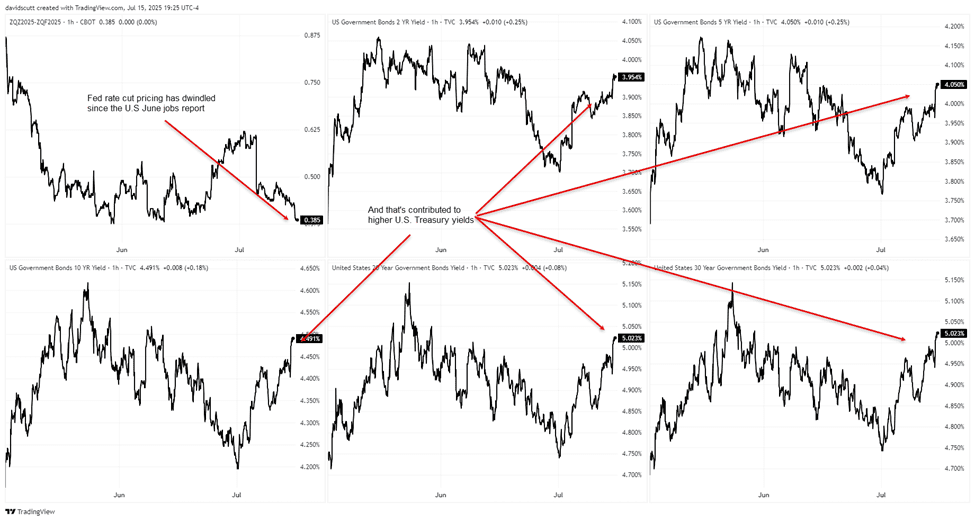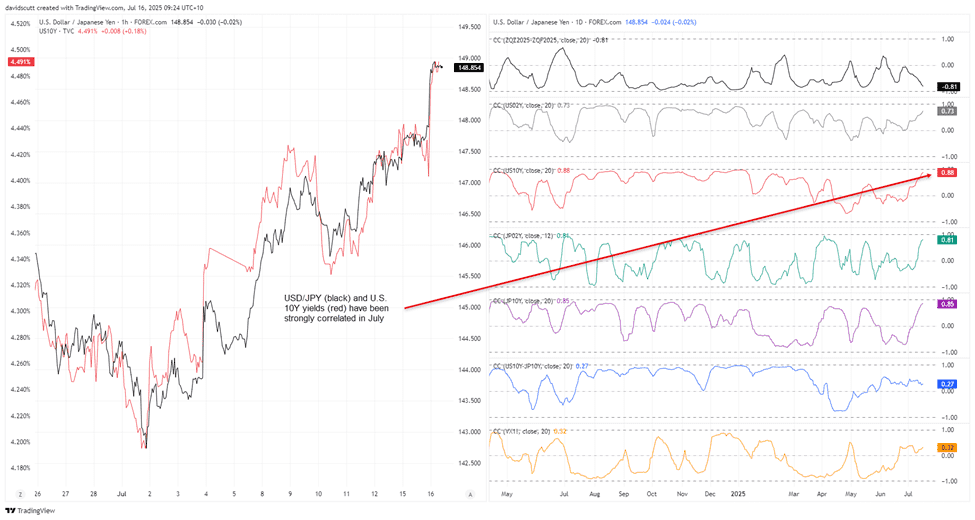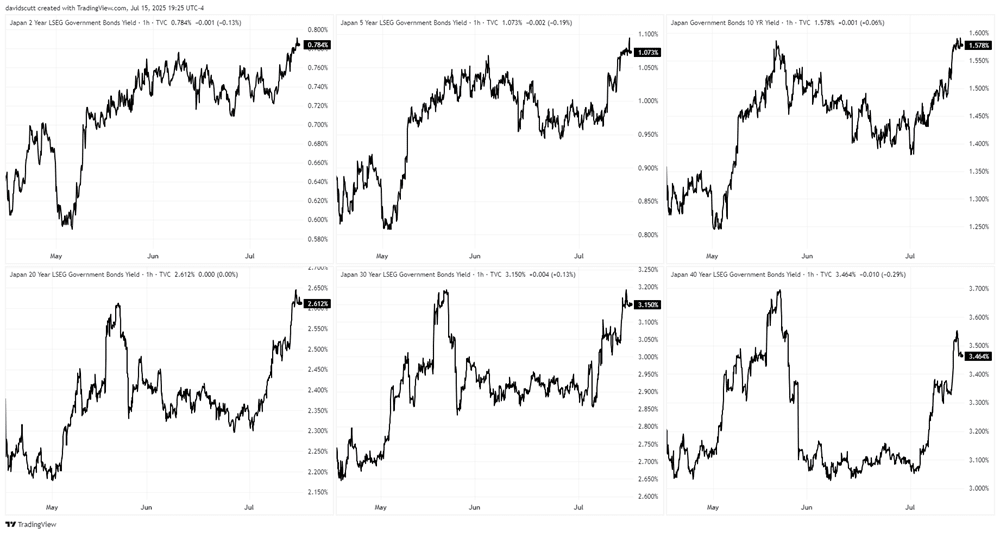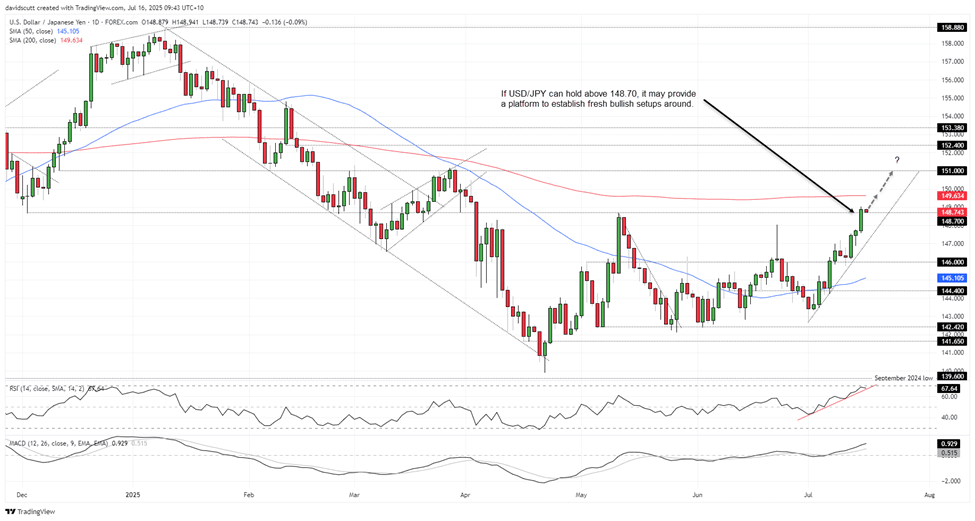Joby Aviation closes $591 million stock offering with full underwriter option
As US rate cut hopes fade and Treasury yields surge, USD/JPY is finding fresh support. With the 200-day in sight, could 150 be next?
- US core CPI +0.2% in June vs. +0.3% expected
- Tariff-exposed goods prices post the strongest rise since 2021
- U.S. yields surge, lifting USD/JPY to its highest since April
- Japanese election risks add to yen pressure despite higher JGB yields
USD/JPY Outlook Summary
The shifting U.S. interest rate outlook is reasserting its grip on USD/JPY movements, with its relationship with benchmark 10-year yields over the past month strengthening to levels not seen since the beginning of the year. As they’ve pushed higher, so too has USD/JPY. With riskier asset classes continuing to rally, until both trends reverse, the path of least resistance for USD/JPY remains higher from both a fundamental and technical perspective.
First Signs of Tariff Impact
U.S. core CPI rose 0.2% in June, softer than the 0.3% forecast and marking a fifth straight subdued print. Core goods prices excluding vehicles jumped 0.55%—the largest increase since late 2021—driven by sharp gains in toys, appliances, and furnishings exposed to import tariffs.
However, both new and used car prices fell, helping cap the overall core goods increase at 0.2%. Services ex housing and energy—the Fed’s preferred ‘supercore’ inflation measure—rose 0.2%, while shelter inflation slowed due in part to falling hotel rates. On an annual basis, core CPI held steady at 2.9%.
Data Fuels Fed Rate Cut Unwind, Higher U.S. Yields
While the core measure undershot expectations again, the lift in prices of goods exposed to tariffs helped fuel concerns that broader inflationary pressures may emerge in the months ahead. That contributed to futures traders scaling back expectations for rate cuts from the Federal Reserve this year to just 38.5 basis points—down sharply from levels seen earlier in the month before the June nonfarm payrolls report.
As shown in the chart below, the repricing has coincided with a sharp lift in U.S. Treasury yields further out the curve, led by 10-year, 20-year and 30-year tenors, which have climbed to multi-month highs.
Source: TradingView
The increase in U.S. Treasury yields has been a major driver behind the surge in USD/JPY over the past month, with the pair adding over six big figures during that stretch. Looking at the rolling monthly correlation coefficient scores below, the relationship between USD/JPY and benchmark 10-year yields has strengthened to levels not seen since January.
Correlations with shorter-dated yields and Fed rate cut expectations are also firming, placing the U.S. interest rate outlook back at the centre of attention—not just headlines around tariffs.
Source: TradingView
Higher Japanese Yields No Help for Yen

Source: TradingView
Interestingly, despite higher Japanese bond yields—one factor behind the lift in U.S. yields—the correlation between U.S.-Japan rate differentials and USD/JPY has remained weak. That’s likely due to renewed concerns about Japan’s fiscal outlook ahead of Sunday’s upper house election, which will see 124 of 248 seats contested. Recent polls suggest Prime Minister Shigeru Ishiba’s ruling LDP–Komeito coalition could lose its majority, fuelling market jitters and helping drive Japanese 10-year and 30-year government bond yields to multi-decade highs this week.
Even though fiscal concerns in the U.S. haven’t disappeared, unease over potential additional Japanese debt issuance to support looser fiscal settings is clearly acting as a headwind for the yen. If the LDP-led coalition does lose control of the upper house, those headwinds are likely to intensify.
USD/JPY Delivers Bullish Break

Source: TradingView
Aided by the latest leg higher for U.S. Treasury yields following the June US inflation report, USD/JPY closed at the highest level since April on Tuesday, taking out the important 148.70 level in the process. If the pair manages to consolidate the break on Wednesday ahead of separate U.S. PPI data for June, the level may revert to offering support, providing a platform for new long positions to be established seeking additional upside.
The 200-day moving average is the first major hurdle for bulls to overcome, sitting today at 149.63. If it were to be taken out, it would only add to the bullish price action seen recently. Above, 150 will naturally receive some attention given it’s a major big figure, although there’s little visible resistance until 151.00.
If USD/JPY were to reverse back below 148.70 and close there, it would provide bulls with some food for thought, opening the door for a potential retest of the uptrend the pair has been sitting in since the start of July. However, the message from momentum indicators like RSI (14) and MACD is firmly bullish. With the 50-day moving average also starting to curl higher, near-term price momentum is definitely with the bulls, favouring buying dips in this environment.
